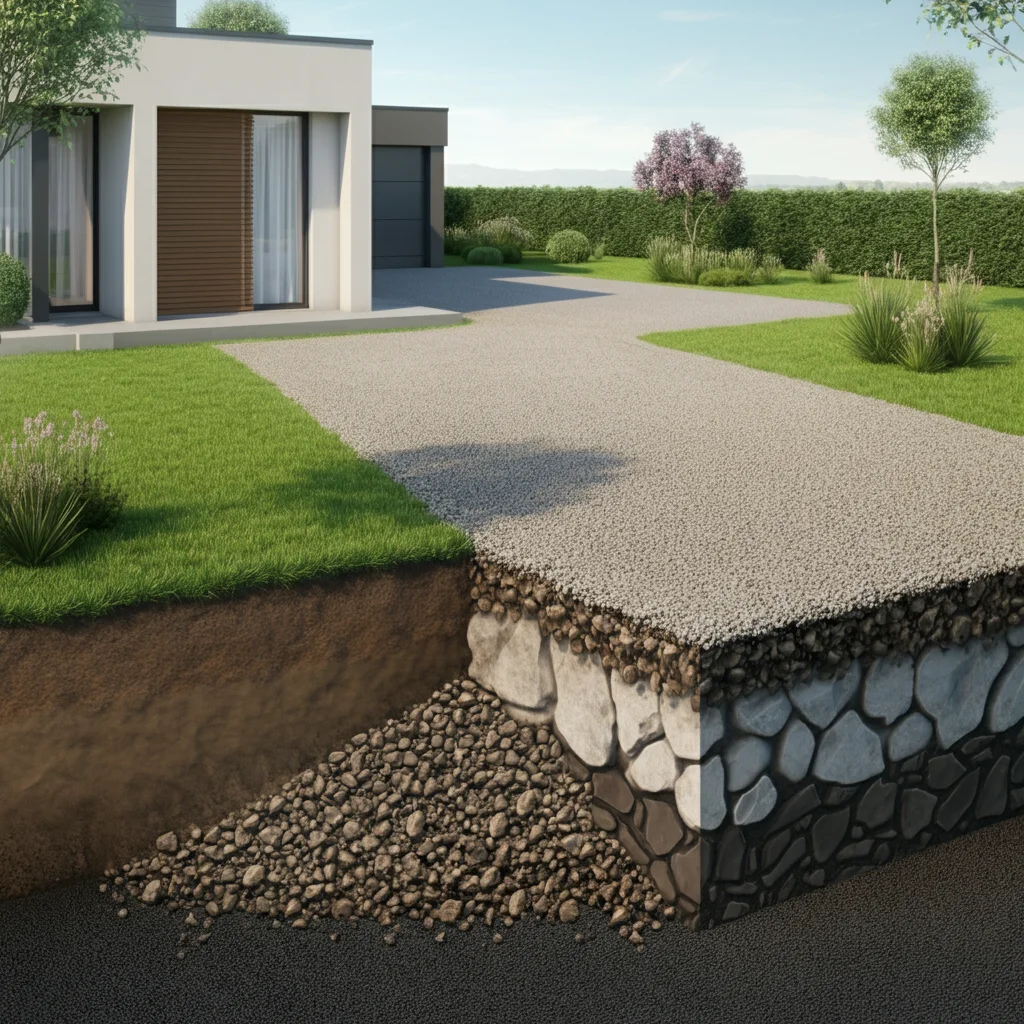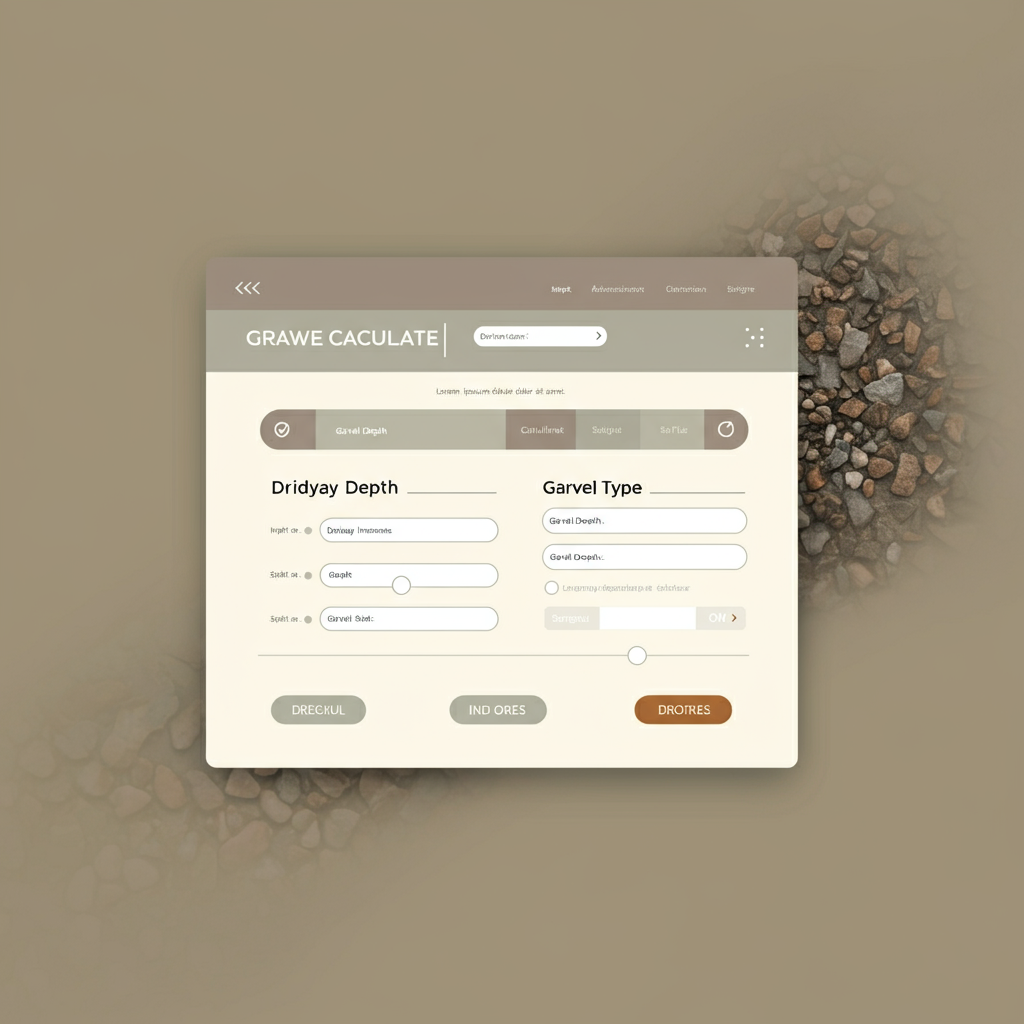Use our Gravel Calculator for Driveways to quickly estimate the exact amount of gravel you need for your project in just a few clicks
Gravel Driveway Calculator
How to Estimate Gravel Needs Accurately
Step 1: Overall Dimensions & Settings
Sub-Base Layer
Middle Layer
Top Layer (Surface)
Driveway Project Totals
🚀 Explore Our Free Online Calculators
Imagine this: you’ve decided to upgrade your driveway, but you’re faced with a common question how much gravel do you need? Gravel driveways are durable, cost-effective, and aesthetically pleasing, but determining the correct amount of gravel is crucial for creating a functional and visually appealing surface. If you order too little, you risk an uneven driveway. Too much? You’re left with wasted money and materials.

This guide will walk you through everything you need to know about calculating gravel for your driveway, covering the factors that influence gravel quantity, methods for calculating, and tips to ensure the best results. Whether you’re planning a DIY project or hiring a contractor, this article will help you make informed decisions.
Why Gravel Driveways Are Popular
Gravel driveways are a top choice for homeowners for several reasons:
- Cost-Effectiveness: Gravel is one of the most affordable driveway materials.
- Durability: Properly installed and maintained gravel driveways can last for decades.
- Aesthetic Appeal: Gravel offers a rustic, natural look that enhances curb appeal.
- Customization: You can choose from various colors, sizes, and textures.
However, their effectiveness hinges on using the right amount of gravel, making calculations an essential step in the process.
Understanding Gravel and Its Role
Gravel, typically made from crushed stone, serves as the foundation for your driveway. A well-designed driveway consists of multiple layers:
- Base Layer: Provides stability and drainage.
- Middle Layer: Offers additional support.
- Top Layer: Enhances appearance and functionality.
Each layer requires a specific size and type of gravel, which impacts how much you’ll need.

Key Factors to Consider Before Calculating Gravel
Several factors determine how much gravel your driveway will require. Here are the most important ones:
1. Driveway Dimensions
The length, width, and depth of your driveway are the primary factors in calculating gravel volume.
2. Gravel Depth
The standard depth for most gravel driveways is 4–6 inches. However, factors like soil type and intended usage may require adjustments.
3. Gravel Type and Size
Gravel comes in various sizes and compositions. Common options include:
- Crushed Stone #57: Ideal for the top layer.
- Crushed Stone #3: Perfect for the base layer.
4. Soil and Drainage Conditions
If your soil is clay-heavy or prone to water retention, you may need additional gravel for stability and drainage.
How to Calculate Gravel for Your Driveway
Calculating gravel is simpler than it sounds. Follow these steps to determine the required amount:
Step 1: Measure Driveway Dimensions
Use a measuring tape to find the length, width, and depth of your driveway. For instance:
- Length: 20 feet
- Width: 10 feet
- Depth: 0.5 feet (6 inches converted to feet)
Step 2: Calculate Volume in Cubic Feet
Multiply the dimensions:
Length × Width × Depth = Volume
Example: 20 ft × 10 ft × 0.5 ft = 100 cubic feet
Step 3: Convert Cubic Feet to Cubic Yards
Gravel is typically sold by the cubic yard. To convert:
Cubic Feet ÷ 27 = Cubic Yards
Example: 100 ÷ 27 ≈ 3.7 cubic yards
Step 4: Account for Compaction and Waste
Add 10–15% extra gravel to account for compaction and potential waste.
Gravel Calculator Formula
Here’s a simplified formula to use:
(L × W × D) ÷ 27 × 1.15 = Gravel in Cubic Yards
Where:
- L = Length (feet)
- W = Width (feet)
- D = Depth (feet)
- 1.15 accounts for compaction and waste.
Gravel Calculator Table
| Driveway Size (ft) | Depth (inches) | Volume (Cubic Yards) |
|---|---|---|
| 20 × 10 | 6 | 3.7 |
| 50 × 12 | 4 | 7.4 |
| 100 × 20 | 6 | 22.2 |
Tips for Buying Gravel
- Choose a Reliable Supplier: Look for local, trusted suppliers to save on delivery costs.
- Buy in Bulk: Ordering larger quantities can reduce costs per cubic yard.
- Inspect Gravel Quality: Ensure the gravel meets your project’s requirements.
Common Mistakes to Avoid
- Underestimating Depth: Always plan for a depth of at least 4–6 inches.
- Skipping Compaction: Compact each layer to prevent uneven surfaces.
- Ignoring Drainage Needs: Proper drainage prevents water pooling and erosion.
Maintenance Tips for Gravel Driveways
- Rake Regularly: Even out displaced gravel to maintain a smooth surface.
- Fill Low Spots: Add gravel to any depressions that form over time.
- Address Drainage Issues: Install drainage systems if necessary.
FAQ
1. How much does gravel cost per cubic yard?
Gravel typically costs $30–$50 per cubic yard, depending on type and location.
2. Can I calculate gravel for irregular-shaped driveways?
Yes. Divide the driveway into sections, calculate each separately, and sum the totals.
3. How long does a gravel driveway last?
With proper maintenance, a gravel driveway can last 20–30 years.
Conclusion
Calculating gravel for your driveway doesn’t have to be daunting. By understanding your project’s needs and following the steps outlined in this guide, you can confidently determine the right amount of gravel, ensuring a durable and attractive driveway. Whether you’re planning a DIY installation or hiring professionals, these tips will set you up for success.
